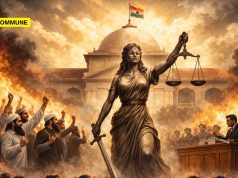
Vijay said, “When I entered politics, some people asked, what do you know brother; How will you survive? Politics is a pit waters (ditch dug surrounding fortress), in there are different kinds of giant crocodiles which are drowned inside the water raising their heads opening their mouths? How will you go into the fort beyond all these people? They kept asking question after question that can you, do it? Shall we tell them a short story in our style?”
He clarified that this story serves not as a source of motivation but as an explanation of their stance and decision-making. Vijay continued, “A great war broke out in a country. Since there was lacking powerful leadership, the responsibility was with a boy. So, all the big people in that country were very scared. The boy after accepting the responsibility declared that he would lead the army to war.”
All the leaders said, ‘You are small boy; this is a battlefield there are many powerful enemies. Facing them on the field is no ordinary task, listen to us, this isn’t a game, you can’t just play and return back to home. War requires you to lead the army and more importantly we should survive all the enemies and more than that we should win. When every leader questioned as you have no allies how will you lead the battle and win? The Sangam literature clearly narrates the actions of this young boy from the Pandya dynasty. Without addressing the leaders’ doubts, he marched into battle alone. For those who haven’t read, read and know or ask those who have read it and find out.”
"கெட்ட பையன் சார் அந்த சின்ன பையன்" – தவெக மாநாட்டில் விஜய் கூறிய குட்டி ஸ்டோரி#TvkVijayMaanadu #TVKVijay #TVKMaanadu #kuttystory #தமிழகவெற்றிக்கழகம் #ETVBharatTamil @tvkvijayhq @actorvijay pic.twitter.com/VsrtS95mDM
— ETV Bharat Tamil nadu (@ETVBharatTN) October 28, 2024
Battle Of Thalaiyalanganam
In the lineage of the Pandya dynasty, at least three individuals named Nedunchezhian are recognized across different eras. Historians often refer to the one who triumphed at Thalaiyalanganam as Nedunchezhian II, while some identify him as Nedunchezhian III. Orphaned at a young age, he ascended to the throne of the Pandya kingdom at just 15 years old.
நளிகட லிருங்குட்டத்து வளிபுடைத்த கலம்போலக்
களிறுசென்று களனகற்றவும் களனகற்றிய வியலாங்கண்
ஒளிறிலைய வெஃகேந்தி. அரைபட வமருழக்கி
உரைசெல முரசுவௌவி
-மாங்குடி கிழவர் மருதனார்( புறநானூறு – 26)
On your elephant, raising the spear with the shining blade.
Penetrated the enemy’s army like a ship with full-blown sail
barging into the huge deep sea.
Slaying thine enemy king and seizing their Royal drum
– Mangudi Maruthaanaar (Puranaanuru 26) by Poet Maangudi Maruthanaar
According to Sangam literature, he is described as a tall figure, with the name Nedunchezhian signifying “the Enhanced” or “the Tall.” He ruled from Madurai, the capital, with Korkai (likely modern Thoothukudi) serving as his main trading port.
Nedunchezhian II was known for trading valuable commodities such as sea conch pearls with the Chinese to the east and the Romans and Athenians to the west. Other traded goods included cotton, ivory, pepper, and sandalwood, in exchange for gold and gems.
His court featured the Chief Bard Maangudi Maruthanaar, who celebrated his victories, particularly at Thalaiyalanganam. Many historians believe that his numerous battles were driven by a desire to control maritime trade, and the resources associated with it.
Throughout his reign, he fought and won many battles, with at least twenty bards from the Sangam period commemorating his valor. Among the most notable were Maangudi Maruthanaar, Nakeerar, and Paranar. A poem attributed to him appears in Agananooru (Number 72), categorized under “Venchinam Mozhithal,” which expresses his determination to defeat his enemies who mocked him for ascending to the throne at a young age. In this poem, he vowed that if he failed to conquer his foes, he would deserve public scorn and live in utter poverty.
Historians have speculated about Nedunchezhian’s motivations for war, suggesting that his early ascent to power led to doubts about his capabilities, prompting him to assert his authority through military might. This is articulated in his “Vociferate to Resolve” poem, which highlights his concern for the justice of his actions.
Another driving factor for his warfare may have been the Pandya obligation to protect the southern territories, known in Tamil as “Thenpula Kaaval.” His most renowned victory occurred at the Thalaiyalanganam battle, located in present-day Alangaanam, Thiruvarur district, where he faced the Chera, Chozha, and five allied armies.
The names of the defeated kings included Maanthrancheral, Cholan Perunarkilli, Thithiyan, Ezhini, Erumaiyuran, Irungkovel, and Perunan. Their defeat taught them a harsh lesson, as they had underestimated Nedunchezhian’s capabilities.
This battle established his historical significance, differentiating him from Nedunchezhian I, who is associated with ‘Arya Padai Kadantha Pandya Nedunchezhian’, known for leading Aryan forces in the north. Nedunchezhian I also features in the tale of Kovalan’s wrongful conviction in Silapathikaram, highlighting themes of justice in Tamil culture.
Nedunchezhian II remained in a state of constant warfare against resource-rich kingdoms, which facilitated maritime trade. His conquests included regions like the Mudumalai and Kutralam ranges, known for their natural wealth. He sought to engage coastal kings to enhance access to seaports and marine resources.
Described as a formidable warrior, he fought from a high seat on his swift elephant, kadumpakattu yaanai, against enemies on horseback. He is celebrated in Sangam literature for his numerous titles, many reflecting the chariots and elephants he commanded.
According to Tamil historian Tenkasi Subramanian, his queen was Thazhumban Paandimaadevi, the protagonist in the Sangam classic Nedunalvaadai.
(With inputs from Tamil Culture)
Subscribe to our channels on Telegram, WhatsApp, and Instagram and get the best stories of the day delivered to you personally




